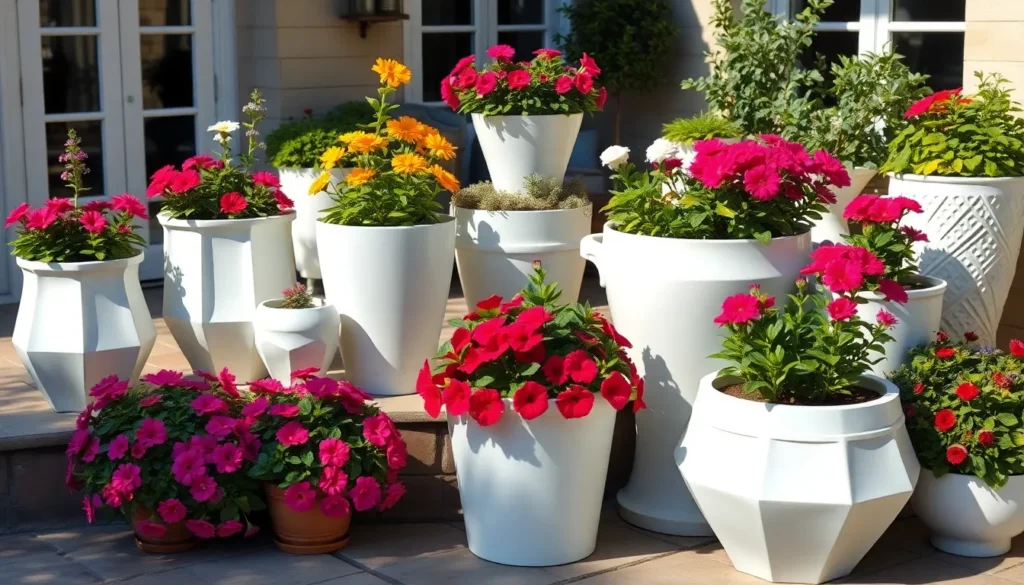White outdoor planters are transforming gardens and patios across America with their timeless elegance and versatility. We’ve discovered that these stunning containers don’t just house your favorite plants—they create focal points that elevate any outdoor space from ordinary to extraordinary. Whether you’re designing a modern minimalist garden or adding contrast to a colorful industry white pots deliver that perfect clean aesthetic we all crave.
The secret lies in their incredible adaptability. White outdoor planters complement virtually every plant variety and architectural style while reflecting sunlight to protect delicate roots from overheating. We’ve seen how they brighten shadowy corners make small spaces appear larger and create cohesive design themes that tie entire outdoor areas together.
From sleek contemporary designs to classic traditional styles we’ll guide you through everything you need to know about selecting caring for and styling white outdoor planters that’ll make your neighbors stop and stare.
Choose the Right Size White Pot for Your Outdoor Plants
Selecting the proper dimensions for your white outdoor planters determines both plant health and visual appeal. We’ll guide you through essential sizing considerations that ensure your plants thrive while maintaining aesthetic harmony.
Consider Plant Root System Requirements
Match pot depth to root development patterns when choosing white containers for outdoor plantings. Shallow rooted plants like lettuce, herbs, and most annuals need containers measuring 6 to 8 inches deep. Deep rooted vegetables such as tomatoes, peppers, and root crops require pots ranging from 12 to 18 inches in depth.
Measure the root ball width before purchasing white outdoor planters to ensure adequate spreading room. Most plants need containers that provide 2 to 4 inches of space around the existing root system. Fast growing plants like hostas and ferns benefit from extra width allowance of 6 to 8 inches.
Consider drainage capacity alongside root space requirements in white plant containers. Larger pots hold more soil volume and retain moisture longer than smaller containers. Plants with extensive root systems need proportionally larger drainage holes to prevent waterlogging issues.
Account for Growth and Maturity Size
Research mature plant dimensions before selecting white pot sizes for outdoor gardens. Small shrubs like boxwood and dwarf conifers reach 2 to 4 feet at maturity and need containers measuring 18 to 24 inches in diameter. Large perennials such as ornamental grasses and flowering shrubs require pots spanning 24 to 36 inches wide.
Plan for annual growth rates when sizing white outdoor planters for fast developing plants. Vegetables like squash and cucumber can triple in size during one growing season. These rapid growers need initial containers measuring at least 20 gallons to accommodate their expansion.
Factor in repotting schedules for long term plant health in white containers. Plants that remain in the same pot for multiple years need extra room for root development. We recommend choosing containers 25% to 50% larger than immediate needs for permanent plantings.
Balance Pot Proportion with Plant Height
Apply the one third rule when matching white pot height to plant dimensions for optimal visual balance. The container should measure approximately one third the total height of the mature plant. A 6 foot tall plant looks proportionate in a 2 foot tall white planter.
Adjust proportions for plant width plus to height considerations for white outdoor containers. Wide spreading plants like ornamental grasses need broader pots rather than taller ones. Narrow upright plants such as columnar evergreens work well in taller white planters.
Consider viewing angles from different perspectives when sizing white pots for outdoor spaces. Ground level plantings appear different from elevated deck or patio viewpoints. We suggest testing pot and plant combinations in their intended locations before making final selections.
Select Durable Materials That Withstand Weather Elements
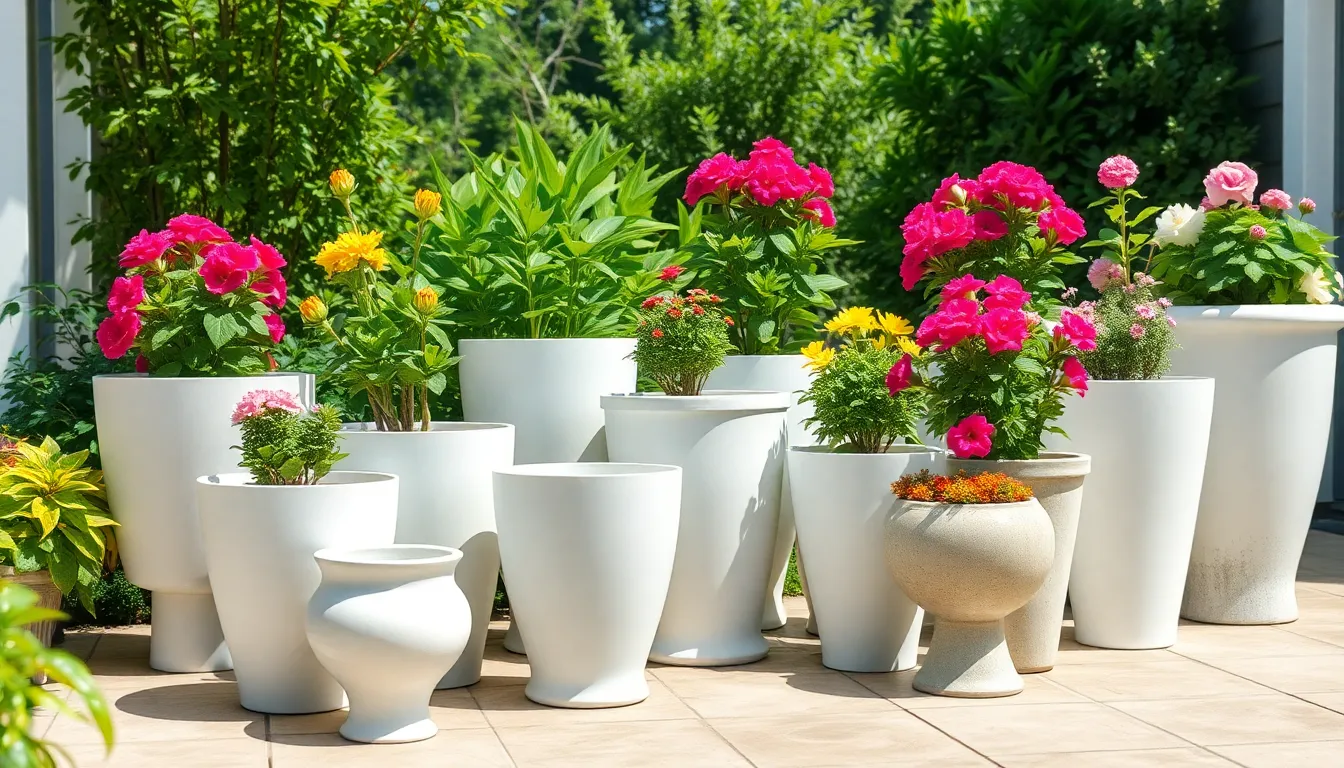
Material choice becomes crucial when investing in white outdoor planters that’ll maintain their beauty through seasons of sun, rain, and temperature changes.
Explore Ceramic and Porcelain Options
Ceramic and porcelain planters offer timeless elegance that complements any outdoor aesthetic. These traditional materials provide sophisticated looks that enhance garden spaces while delivering reliable performance when properly glazed to resist moisture and temperature fluctuations.
Weight considerations make ceramic and porcelain planters best suited for permanent placement in sheltered outdoor areas like covered patios or protected entryways. We recommend positioning these planters where they won’t need frequent relocation, as their substantial weight can make moving challenging once filled with soil and plants.
Glazing quality determines how well ceramic planters withstand outdoor conditions. Properly glazed ceramic pots resist cracking from freeze-thaw cycles and maintain their pristine white finish through UV exposure and weather variations.
Consider Fiberglass and Resin Alternatives
Fiberglass planters represent the gold standard for outdoor white containers, combining exceptional durability with practical lightweight construction. These weather-proof planters resist UV damage, extreme temperatures, and direct sunlight without fading or cracking, making them ideal for high-exposure locations.
Versatility sets fiberglass apart with available shapes including rectangles, cubes, and cylinders in sizes ranging from small tabletop models to large tall planters exceeding 28 inches in height. This variety allows us to match any outdoor space requirement while maintaining consistent white aesthetics.
Portability remains a key advantage since fiberglass planters stay easy to move even when filled with soil and plants. This mobility makes seasonal rearrangement possible for patios, balconies, and entryways without requiring multiple people or equipment.
Resin planters offer similar weather resistance with robust construction that typically surpasses standard plastic durability. Large white resin pots provide excellent alternatives for gardeners seeking substantial planters without the weight penalties of traditional materials.
Evaluate Concrete and Stone Varieties
Concrete planters deliver exceptional durability and weather resistance that withstands all outdoor conditions with minimal maintenance requirements. These rugged containers create natural, rustic aesthetics that complement industry designs emphasizing organic elements and substantial architectural features.
Permanence defines concrete and stone planters since their considerable weight makes relocation difficult once positioned. This characteristic suits gardeners planning long-term outdoor arrangements where planters won’t require frequent moving or seasonal storage.
Texture differences distinguish concrete from smoother materials, offering coarser surfaces and more muted white coloring compared to fiberglass alternatives. Stone varieties share similar durability traits while providing unique natural patterns and textures that age beautifully in outdoor environments.
Maintenance requirements stay minimal for concrete and stone planters, though their heavy construction can lead to damage if frequent relocation becomes necessary. These materials excel in permanent installations where their substantial presence enhances outdoor spaces without requiring ongoing adjustments.
Ensure Proper Drainage Features in White Outdoor Planters
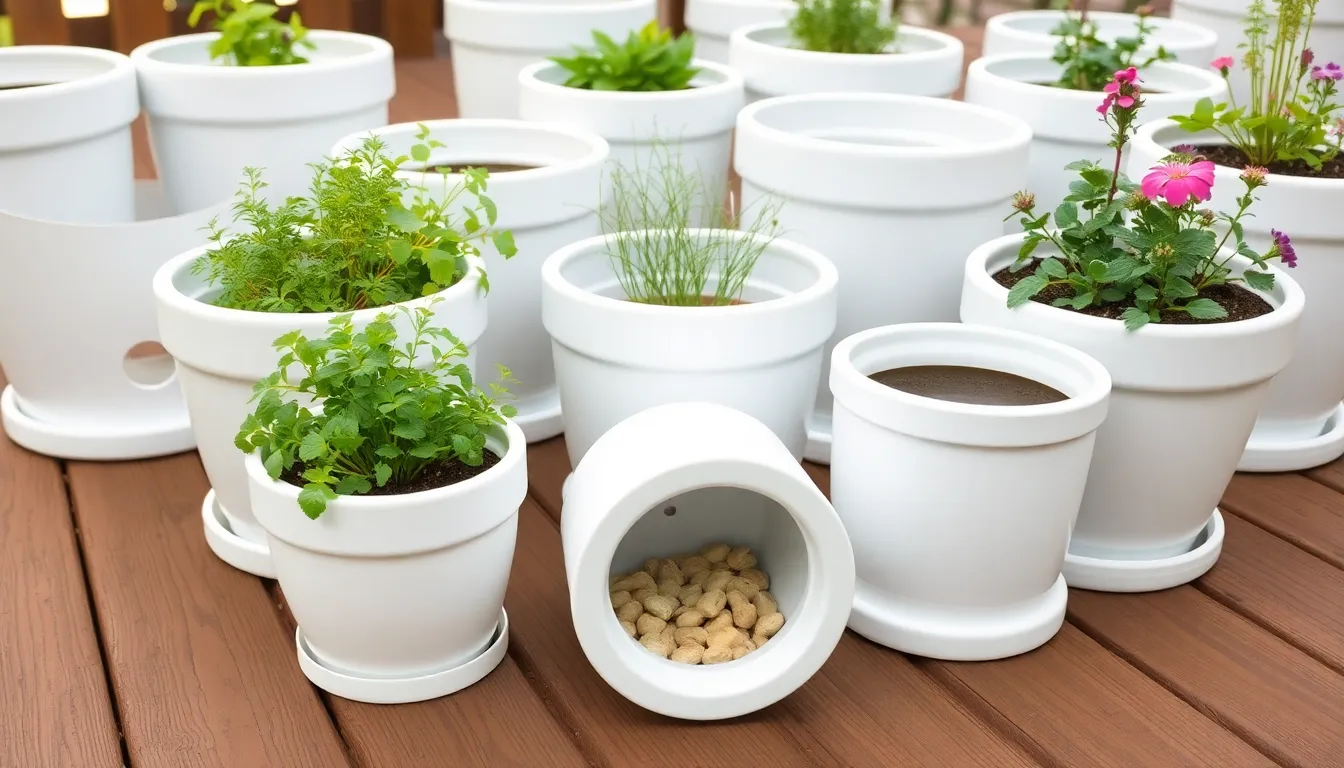
Proper drainage stands as the foundation of successful container gardening with white outdoor planters. Without adequate water management, even the most beautifully selected white pots can become death traps for your plants.
Look for Pre-Drilled Drainage Holes
Many modern white planters come equipped with pre-drilled drainage holes that prevent water from pooling at the base and causing root rot. We recommend always confirming the presence of these essential features before purchasing, as not all manufacturers include them by default. Some companies offer models both with and without drainage holes, allowing you to customize according to your exact planting needs.
Carefully drilling holes yourself becomes an option if your chosen planter lacks them, though we advise caution with fragile materials like ceramic. The holes should measure approximately half an inch in diameter and be spaced evenly across the bottom surface. Multiple drainage points work better than a single large opening for consistent water flow.
Add Drainage Layers and Saucers
Adding drainage layers at the bottom of white outdoor planters improves water flow and prevents soil from clogging the holes. We suggest using materials like pebbles, gravel, or broken pottery to create a one to two inch barrier between the drainage holes and your potting soil. This technique proves especially valuable in deep or large planters where water might otherwise accumulate.
Matching saucers collect runoff and prevent messes on patios, decks, or balcony surfaces while maintaining moisture levels during dry periods. These accessories allow excess water to be reabsorbed when needed, creating a more stable growing environment. We find that saucers work particularly well with white planters since they maintain the clean, cohesive aesthetic.
Consider Self-Watering Systems
Self-watering systems in white outdoor planters provide consistent moisture by allowing plants to draw water as needed. These innovative designs feature built-in reservoirs or wicking mechanisms that reduce the risk of both over-watering and under-watering. We’ve noticed these systems becoming increasingly available in modern white planter designs.
Built-in water gauges help monitor reservoir levels without guesswork, making maintenance simpler for busy gardeners. The systems work especially well for vacation care or areas where daily watering isn’t practical. We recommend self-watering white planters for herbs, vegetables, and moisture-loving plants that benefit from steady hydration.
Position White Pots Strategically for Maximum Visual Impact
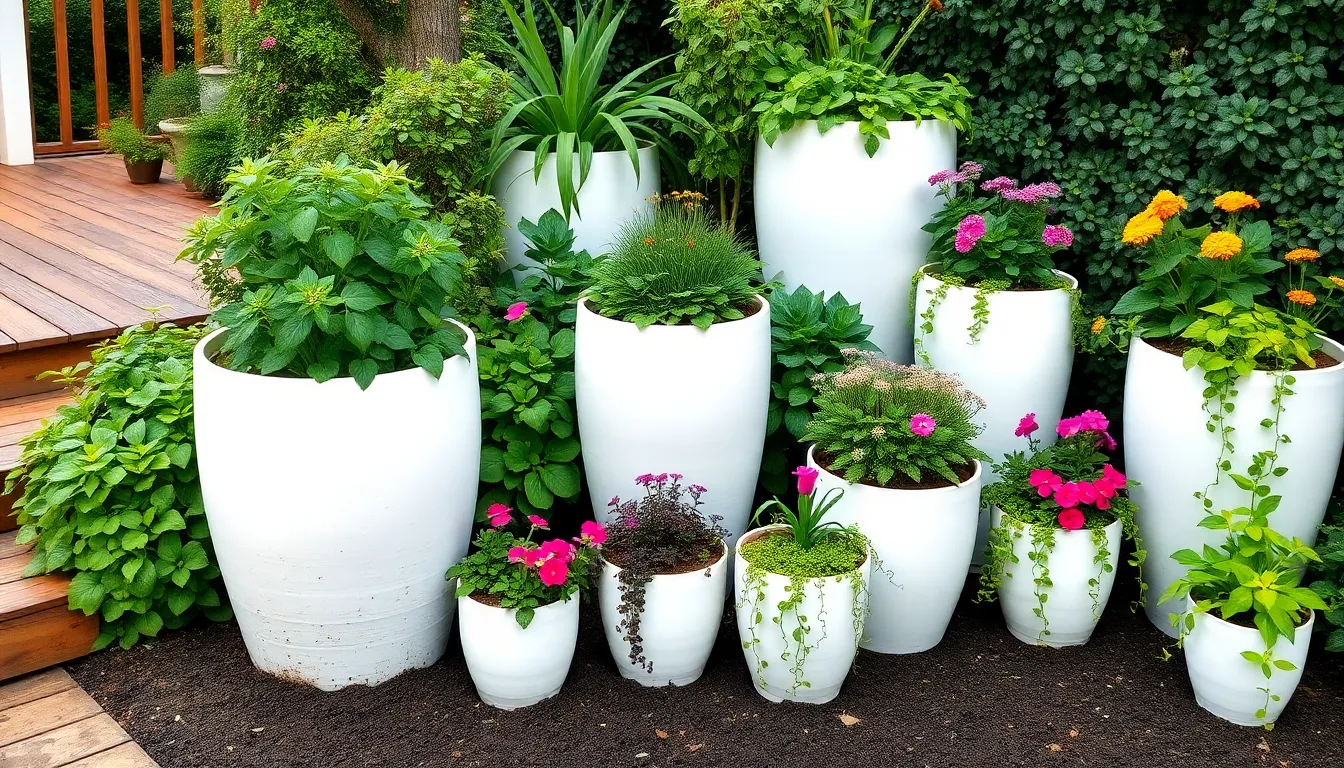
Strategic placement transforms ordinary white planters into stunning garden features that command attention. We recommend positioning these elegant containers against contrasting backgrounds like darker soil, rich green foliage, or wooden decking to maximize their visual impact.
Create Focal Points with Larger Statement Pieces
Large white planters serve as powerful statement pieces that anchor your outdoor design scheme. We position these substantial containers near key areas like doorways, patios, or garden entrances where they’ll make the strongest impression on visitors.
Pairing big white planters with mature plants or small trees creates striking focal points that elevate your garden’s overall style. These combinations provide essential structure to your layout while drawing the eye naturally through your outdoor space.
Strategic placement of oversized white containers helps define different zones within your garden or patio area. We use these bold pieces to mark transitions between seating areas, walkways, or garden beds for better flow and organization.
Group Multiple Pots for Layered Design
Clustering several white pots of different sizes forms layered arrangements that add depth and visual interest to any outdoor setting. We arrange these groupings to create natural conversation points while maintaining balance throughout the space.
Mixing plants with varying textures within grouped white containers produces ever-changing displays that capture attention from multiple angles. Ornamental grasses, flowering perennials, and trailing vines work together to create compelling combinations.
Maintaining a monochromatic planting scheme across clustered white pots delivers a classic, elegant look that never goes out of style. We select plants in similar color families or stick to all-green foliage for sophisticated restraint.
Odd-numbered groupings of white planters typically create more natural, pleasing arrangements than even numbers. We arrange three or five pots together, varying their sizes to establish visual hierarchy and prevent monotony.
Use Height Variations for Ever-changing Arrangements
Arranging white pots at different heights using stands, pedestals, or elevated surfaces adds movement and prevents flat, boring layouts. We incorporate various elevations to create captivating outdoor displays that draw viewers in.
Plant stands and decorative pedestals transform ordinary white containers into elevated garden features. These accessories allow us to showcase smaller plants at eye level while creating tiered arrangements that maximize vertical space.
Placing some white pots directly on surfaces while elevating others introduces natural rhythm to your outdoor design. We balance ground-level containers with raised pieces to establish visual flow and maintain viewer interest.
Incorporating trailing plants in elevated white containers creates cascading effects that soften hard edges and add graceful movement. Ivy, petunias, and spillover varieties work beautifully when positioned at varying heights throughout your arrangement.
Maintain UV Resistance to Prevent Fading and Cracking
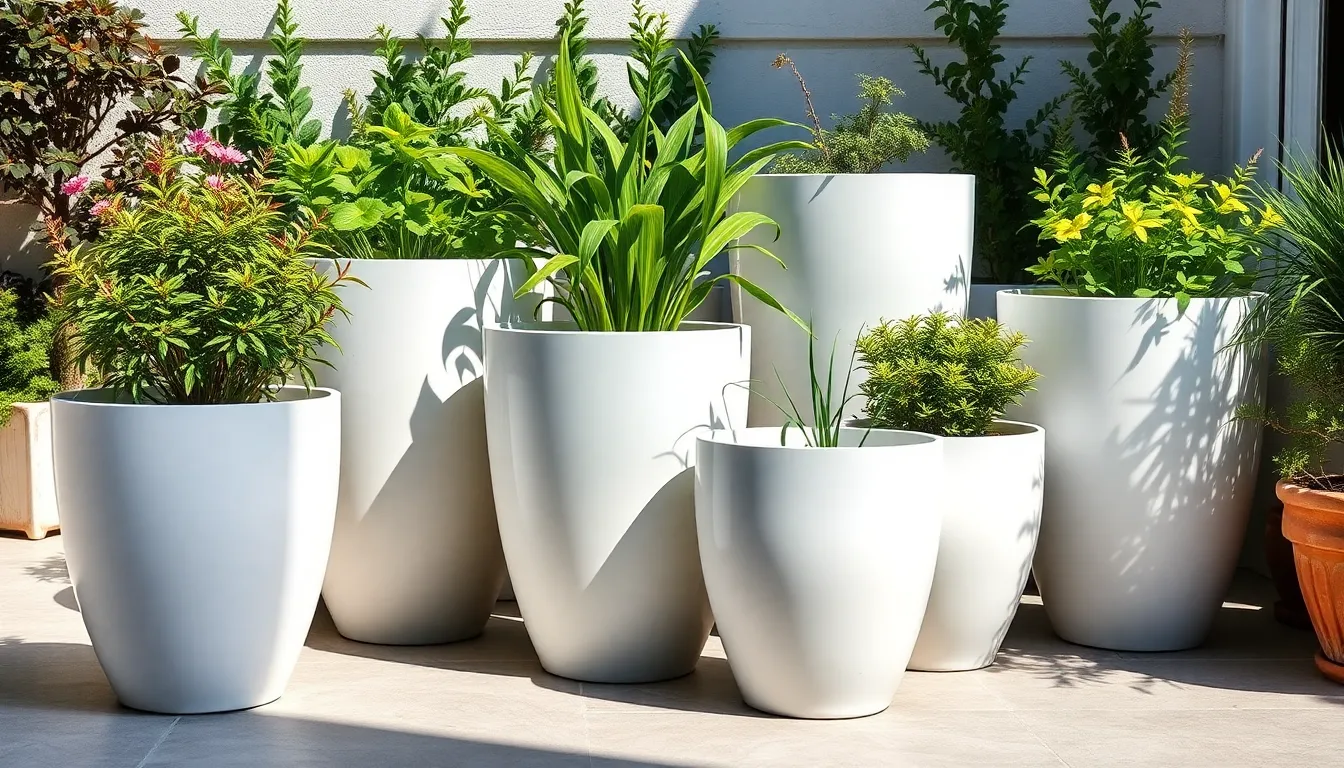
UV-resistant white pots retain their bright white color longer and prevent materials from becoming brittle or warped under constant sun exposure. Protecting our outdoor planters from ultraviolet damage ensures both lasting beauty and structural integrity in high-exposure environments.
Choose UV-Stabilized Materials
Heavy-duty resin fiberglass stands as our top choice for UV-stabilized white outdoor planters that resist fading and cracking. These materials undergo special treatment during manufacturing to withstand intense sunlight and extreme weather without losing their pristine appearance. Polypropylene planters offer another excellent UV-resistant option that maintains structural integrity even after years of sun exposure. Ceramics treated specifically for UV resistance provide elegant durability for patio and garden settings where both style and longevity matter.
We recommend checking manufacturer specifications to ensure your white pots feature genuine UV stabilization rather than basic plastic construction. Materials designed for outdoor use contain special additives that block harmful ultraviolet rays from penetrating the pot’s surface. Quality UV-stabilized planters resist the chalky, yellowed appearance that affects untreated containers after prolonged sun exposure.
Apply Protective Coatings When Necessary
Clear UV-blocking sprays create an additional barrier against ultraviolet damage for pots that lack inherent UV treatment. These protective coatings form a transparent shield that reflects harmful rays while maintaining the clean white finish we desire for our outdoor spaces. Professional-grade clear coats offer enhanced protection and can extend the lifespan of both ceramic and plastic planters significantly.
We suggest applying these coatings before the first season of outdoor use to maximize their effectiveness. Multiple thin coats provide better coverage than single heavy applications that may streak or create uneven protection. Reapplication every 2-3 years ensures continued UV resistance as protective coatings naturally wear down over time.
Rotate Pots to Ensure Even Sun Exposure
Regular rotation prevents uneven fading and wear on white outdoor planters by distributing sun exposure across all surfaces. We recommend turning pots a quarter turn every few weeks during peak growing season to maintain uniform color and prevent one-sided deterioration. This simple maintenance practice helps our white planters retain their consistent appearance throughout the outdoor season.
Strategic positioning also plays a role in managing sun exposure for our container gardens. Moving planters to slightly shadier locations during the hottest part of summer protects both plants and pot materials from excessive UV damage. Seasonal adjustments allow us to balance optimal plant growth with container longevity in our outdoor spaces.
Complement Your Garden Design with White Pot Styles
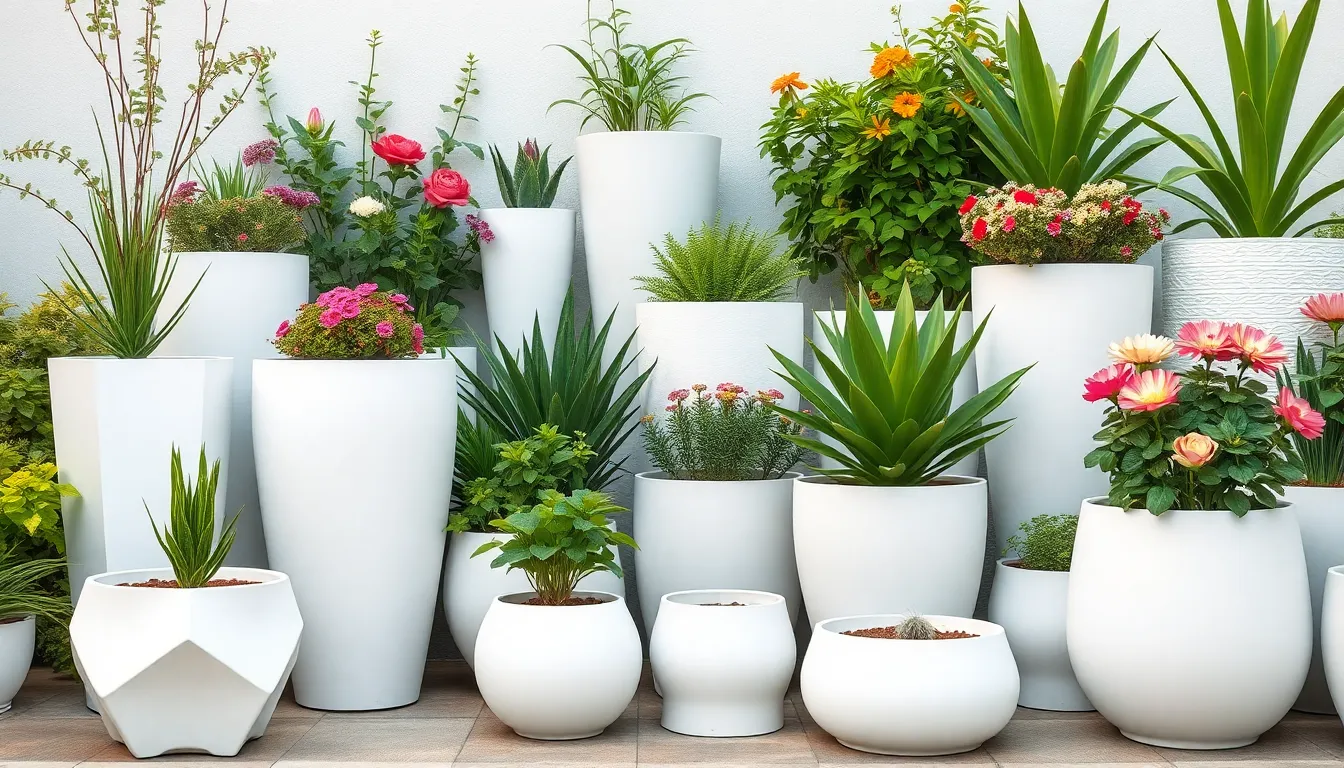
White outdoor pots offer exceptional versatility in diverse shapes and sizes that transform any garden aesthetic. Strategic selection of pot styles creates dramatic focal points while establishing cohesive design themes throughout your outdoor spaces.
Match Contemporary Homes with Sleek Modern Designs
Modern white outdoor planters feature geometric precision with minimalist rounds, cylinders, cubes, and rectangular forms that emphasize clean architectural lines. Fiberglass construction delivers lightweight portability while maintaining weatherproof durability in various climates. Brushed aluminum and stainless steel options provide chic urban flair that complements sleek contemporary home exteriors perfectly.
Large floor planters anchor open spaces and mark sight lines with architectural sophistication. Cement varieties offer substantial presence for dividing outdoor areas or emphasizing entryways with modern elegance. UV resistant materials ensure these contemporary designs maintain their pristine appearance across seasons without fading or cracking.
Pair Traditional Architecture with Classic Shapes
Classic white pots in round and oval forms seamlessly blend with traditional garden styles while showcasing timeless appeal. These elegant shapes create harmonious connections between classic home exteriors and surrounding garden landscapes. Round planters bring sophisticated charm to porches and patios where traditional architecture calls for refined simplicity.
Medium sized pots work ideally for grouping arrangements that add visual interest to intimate patio vignettes. Oval designs complement formal garden beds while maintaining the classic proportions that traditional settings require. These shapes help showcase lush greenery and flowering plants with understated elegance that never overwhelms architectural details.
Blend Rustic Settings with Textured Finishes
Textured white planters with wood inspired finishes provide gentle contrast while maintaining natural appeal in rustic outdoor environments. Distressed matte surfaces add rustic charm without overpowering the organic beauty of plants or existing garden materials. These finishes balance naturally with wood, stone, and brick elements to create inviting layered industry scenes.
Small tabletop pots with textured surfaces work perfectly for creating intimate groupings on rustic patios and balconies. Wood like finishes offer authentic appeal that complements natural outdoor materials while retaining the brightness benefits of white containers. These textured options maintain durability while delivering the weathered aesthetic that rustic settings demand.
Care for White Outdoor Plant Pots Throughout the Seasons
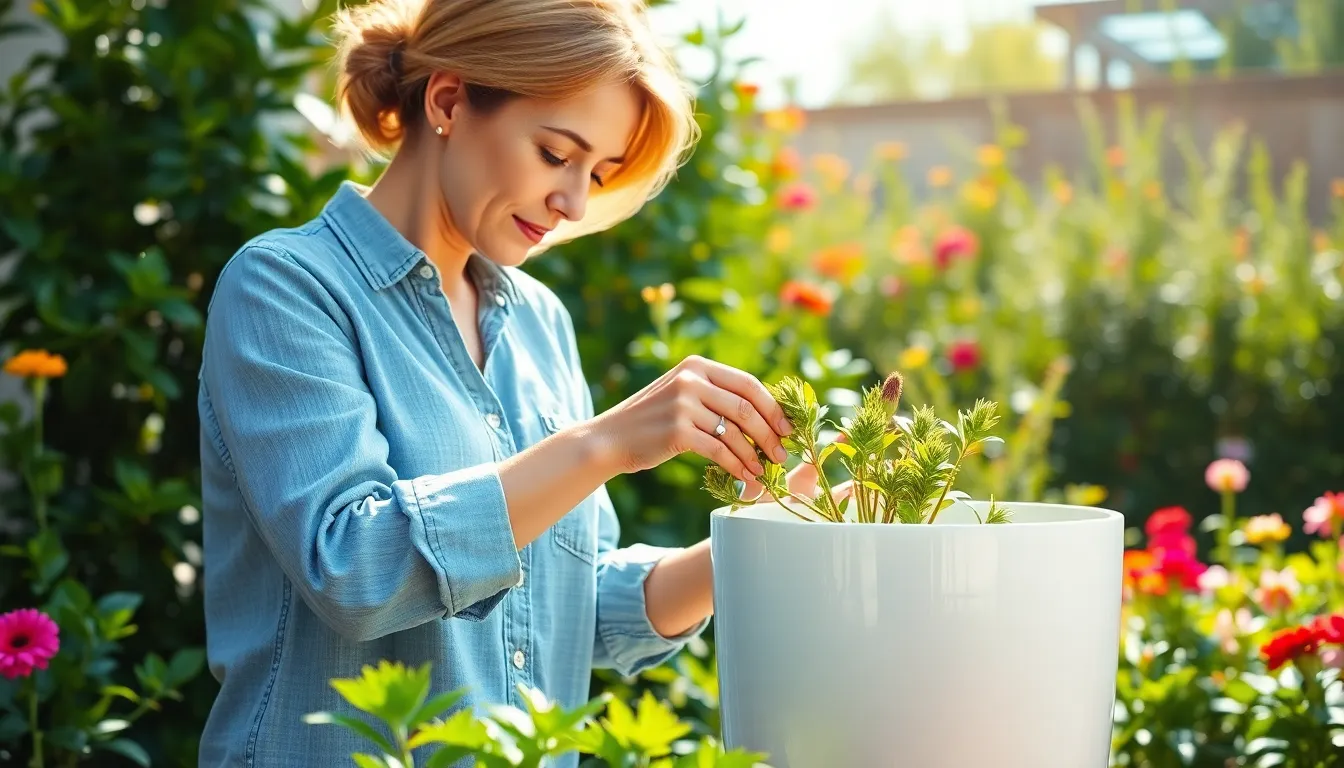
Maintaining white outdoor planters requires consistent attention throughout the year since their bright color reveals dirt, algae, and mineral deposits more readily than darker containers.
Clean Regularly to Maintain Bright Appearance
Routine cleaning keeps white pots looking fresh and prevents permanent staining. We recommend wiping down pot exteriors with a damp cloth or sponge using mild soapy water to remove daily dirt accumulation. This simple practice prevents stains from becoming embedded in the material’s surface.
Deep cleaning tackles stubborn buildup that routine maintenance can’t handle. Use a soft brush or non-abrasive cleaner for algae growth or mineral deposits that resist regular washing. Steel wool and harsh chemicals should be avoided since they can dull the finish or remove protective coatings from the pot surface.
Frequency matters when preserving the pristine white appearance. Clean your pots at least once per season or immediately when dirt becomes noticeable. This schedule helps maintain the bright white color while protecting the underlying material from damage.
Protect from Extreme Temperature Changes
Material resilience varies with different temperature stresses throughout the seasons. Fiberglass and resin pots resist cracking in cold weather better than other materials, but prolonged exposure to extreme temperature swings can still cause stress or fading over time.
Strategic placement minimizes sun induced damage and overheating stress. Position white pots in locations with partial shade to reduce discoloration and thermal stress during peak summer months. This approach protects both the container material and plant roots from excessive heat exposure.
Watering practices directly impact pot longevity during temperature extremes. Avoid letting standing water remain in containers during intense heat or cold periods, as rapid temperature changes can harm plant roots and indirectly affect the pot’s structural integrity.
Store Properly During Winter Months
Winter storage protects white pots from harsh freezing conditions in colder regions. Consider bringing containers indoors or moving them to sheltered areas like garages or covered patios to prevent freeze damage. This practice extends the lifespan of your white outdoor planters significantly.
Pre storage cleaning prevents off season problems from developing. Always clean pots thoroughly before storing to eliminate mold, mildew, or algae buildup during inactive months. This step ensures your containers emerge ready for spring planting without contamination issues.
Drainage considerations remain critical for pots staying outdoors through winter. Ensure containers have adequate drainage holes and place them on surfaces that allow proper airflow and water runoff. This prevents water accumulation that could freeze and crack the pot material.
| Care Step | Recommended Action |
|---|---|
| Clean Regularly | Use mild soap and soft cloth, avoid abrasives |
| Protect from Temperature | Use shade placement, avoid extreme shifts |
| Store in Winter | Move indoors, clean before storing |
Conclusion
White outdoor planters offer us an unmatched combination of style and functionality that transforms any outdoor space into a sophisticated garden retreat. We’ve explored how these versatile containers provide both aesthetic appeal and practical benefits that support healthy plant growth throughout the seasons.
The key to success lies in making informed choices about materials drainage features and proper sizing to ensure our plants thrive while creating stunning visual displays. Whether we’re designing a modern patio or a traditional garden white pots adapt seamlessly to our vision.
With proper maintenance and strategic placement these timeless containers will continue improving our outdoor spaces for years to come. They’re truly an investment in both our garden’s beauty and our plants’ long-term health.
Frequently Asked Questions
What are the main benefits of using white outdoor planters?
White outdoor planters offer timeless elegance and exceptional versatility for any garden or patio design. They help protect plant roots from overheating by reflecting sunlight, brighten darker outdoor areas, and complement both modern and traditional architectural styles. Their neutral color allows plants to be the focal point while providing a clean, cohesive look.
How do I choose the right size white planter for my plants?
Match the pot depth to your plant’s root system and account for future growth. Use the one-third rule: the planter should be roughly one-third the height of mature plants for visual balance. Measure the root ball width and add 2-4 inches for adequate space, while ensuring sufficient drainage capacity.
What materials are best for white outdoor planters?
Ceramic and porcelain offer elegant finishes but work best in sheltered areas. Fiberglass and resin are lightweight, weather-resistant, and versatile for high-exposure locations. Concrete and stone provide maximum durability and rustic appeal for permanent installations. Choose UV-stabilized materials to prevent fading and cracking.
How important is drainage in white outdoor planters?
Proper drainage is crucial for plant health and preventing root rot. Look for pre-drilled drainage holes and add drainage layers using pebbles or gravel. Use saucers to collect runoff and maintain appropriate moisture levels. Consider self-watering systems for consistent hydration, especially for herbs and moisture-loving plants.
How should I arrange white planters for maximum visual impact?
Position white planters against contrasting backgrounds and use larger pieces as focal points. Group multiple pots of varying sizes for layered arrangements that add depth. Incorporate height variations using stands and pedestals, and maintain monochromatic planting schemes for a classic, cohesive look.
How do I maintain white outdoor planters throughout the seasons?
Clean regularly with mild soapy water, as white surfaces show dirt more readily. Avoid harsh chemicals that could damage finishes. Protect from extreme temperatures by placing in partial shade and ensuring proper watering. For winter, move pots to sheltered areas and clean thoroughly before storage to prevent mold.
Do white planters need UV protection?
Yes, UV resistance is essential for maintaining appearance and structural integrity. Choose UV-stabilized materials like heavy-duty resin, fiberglass, or polypropylene. Check manufacturer specifications for genuine UV stabilization, apply protective coatings when recommended, and rotate pots regularly to ensure even sun exposure and prevent damage.

